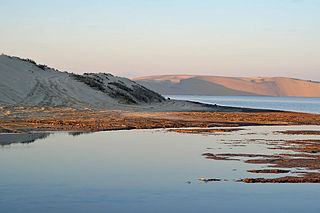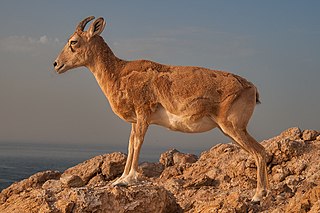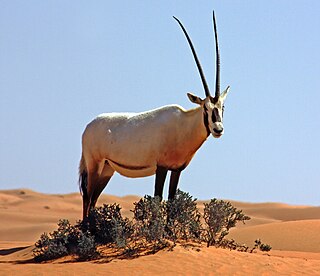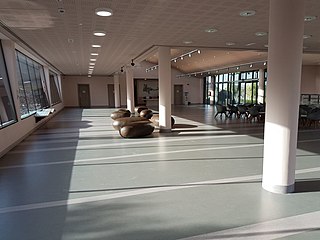
A nature reserve is a protected area of importance for flora, fauna, or features of geological or other special interest, which is reserved and managed for purposes of conservation and to provide special opportunities for study or research. They may be designated by government institutions in some countries, or by private landowners, such as charities and research institutions. Nature reserves fall into different IUCN categories depending on the level of protection afforded by local laws. Normally it is more strictly protected than a nature park. Various jurisdictions may use other terminology, such as ecological protection area or private protected area in legislation and in official titles of the reserves.

The Arabian Desert is a vast desert wilderness in Western Asia that occupies almost the entire Arabian Peninsula. It stretches from Yemen to the Persian Gulf and Oman to Jordan and Iraq. It occupies most of the Arabian Peninsula, with an area of 2,330,000 square kilometers (900,000 sq mi). It is the fifth largest desert in the world, and the largest in Asia. At its center is Ar-Rub' al-Khali, one of the largest continuous bodies of sand in the world. It is an extension of the Sahara Desert.

Ṣīr Banī Yās is a natural island located 170 km (110 mi) southwest of Abu Dhabi, the capital of the United Arab Emirates. It lies 9 km (5.6 mi) offshore from Jebel Dhanna, which serves as a crossing point to other islands such as Dalma. Sir Bani Yas is 17.5 km (10.9 mi) from north to south and 9 km (5.6 mi) from east to west, making it the largest natural island in the United Arab Emirates. Located just off the shore of the western region of Abu Dhabi, Sir Bani Yas was originally home to Arabia's largest wildlife reserve. Spanning over 87 km2 (34 sq mi), the reserve was established in 1977 by Sheikh Zayed Bin Sultan Al Nahyan. Due to decades of conservation work and ecological investment, it is now home to thousands of large free-roaming animals and several million trees and plants. A bird sanctuary as well as a wildlife reserve, Sir Bani Yas showcases nature through activities such as adventure safaris, kayaking, mountain biking, archery, hiking and snorkeling.

The Arabian leopard is a leopard subspecies native to the Arabian Peninsula. It has been listed as Critically Endangered on the IUCN Red List since 1996 as fewer than 200 wild individuals were estimated to be alive in 2006. The population is severely fragmented. Subpopulations are isolated and not larger than 50 mature individuals. The population is thought to decline continuously.

Ras Al Khor Wildlife Sanctuary is a wetland reserve in Dubai, renowned for attracting large numbers of migratory birds. It is also home to a large population of crustaceans, small mammals, and fish.

Sir Abu Nuʽayr, Sir Bu Nuʽayr, or Sir al Qawasim is an island in the Persian Gulf.

Wadi Wurayah is a 12,700-hectare (31,000-acre) wadi between the towns of Masafi, Khor Fakkan, and Bidiyah in the United Arab Emirates. It has been designated as Ramsar Wetland of International Importance.

The Arabian oryx, also called the white oryx, was extinct in the wild as of 1972, but was reintroduced to the wild starting in 1982. Initial reintroduction was primarily from two herds: the "World Herd" originally started at the Phoenix Zoo in 1963 from only nine oryx and the Saudi Arabian herd started in 1986 from private collections and some "World Herd" stock by the Saudi National Wildlife Research Center (NWRC). As of 2009 there have been reintroductions in Oman, Saudi Arabia, Israel, the United Arab Emirates, and Jordan, and as of 2013 the IUCN Red List classifies the species as vulnerable.

Protected areas of Qatar include:

The Gulf of Oman desert and semi-desert is a coastal ecoregion on the Persian Gulf and the Gulf of Oman in Oman and the United Arab Emirates at the northeastern tip of the Arabian Peninsula. The climate is hot and dry, with gravelly plains and savanna with thorny acacia trees inland from the coast. Along the coast there are mixture of habitats that include mangrove swamps, lagoons and mudflats. The mangrove areas are dominated by Avicennia marina and the savanna by Prosopis cineraria and Vachellia tortilis. Masirah Island is an important breeding area for the loggerhead sea turtle and other sea turtles also occur here, as well as a great variety of birds, some resident and some migratory. There are some protected areas, but in general the habitats have been degraded by the grazing of livestock, especially camels and goats; they are also at risk from oil spills, off-road driving and poaching.

Qatar is a peninsula on the northeastern coast of the Arabian Peninsula, bordering Saudi Arabia to the south and surrounded elsewhere by the Persian Gulf. A strait separates Qatar from the island kingdom of Bahrain.

The flora of Qatar includes more than 300 species of wild plants. Qatar occupies a small desert peninsula that is around 80 km from east to west and 160 km from north to south. The climate is hot and humid with sporadic rain. Majority of the country is flat with an annual rainfall average of less than 3 inches. Arnebia hispidissim blooms yellow flowers annually in sandy soil. Glossonema edule has edible fruits with brownish-yellow flowers.

The wildlife of the United Arab Emirates is the flora and fauna of the country on the eastern side of the Arabian Peninsula and the southern end of the Persian Gulf. The country offers a variety of habitats for wildlife including the coast, offshore islands, mangrove areas, mudflats, salt pans, sand and gravel plains, sand dunes, mountain slopes, wadis and rocky summits. Because the terrain is so varied, it supports a greater number of species of plants and animals than might have been expected in this relatively small country.

The wildlife of Oman is the flora and fauna of this country in the southeastern corner of the Arabian Peninsula, with coasts on the Gulf of Oman and the Arabian Sea. The climate is hot and dry, apart from the southeastern coast, and the country offers a variety of habitats for wildlife including mountains, valleys, deserts, coastal plains and sea coasts.

Al Marmoom Desert Conservation Reserve is the first unfenced nature conservation reserve in the United Arab Emirates. It is located in the desert area of Saih Al Salam in the emirate of Dubai and comprises some 10% of the total land area of the emirate, including the extensive man-made desert wetlands, Al Qudra Lakes.

Al Hefaiyah Mountain Conservation Centre is a wildlife reserve and visitor centre located west of the coastal town of Kalba in the Emirate of Sharjah, the United Arab Emirates (UAE).
Al Wathba is a suburb of Abu Dhabi in the United Arab Emirates that has a wetland nearby. It is located not too far from the international airport.

The Al Wohoosh Desert Conservation Reserve, is a natural protected area of the United Arab Emirates, established in 2014, which is located in the eastern area of the Emirate of Dubai.

Al Houbara Protected Area is a natural reserve in the United Arab Emirates, and it is located in the emirate of Abu Dhabi. It is named after the large ground bird, Houbara, which belongs in the Persian Gulf region. This reserve consists of abundant plantation and coastal plains on well-drained sandy and gravelly terrain.


















